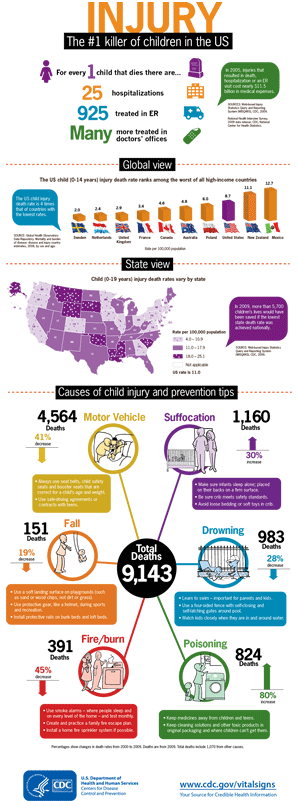Starting from the time when drawings on cave walls portrayed tales about human life, people have been using images to tell their stories. Even a simple image can quickly communicate thousands of details, increase understanding about a difficult topic, or help us comprehend the relevance of complex data.
As the Director of CDC’s Injury Center, I think we need to ensure that we are presenting data in a way that illustrates the problem of injury and violence, and brings a sense of urgency to injury and violence prevention.
 We recently released a CDC Vital Signs on childhood injury prevention, coinciding with our launch of the National Action Plan for Child Injury Prevention. The launch included this infographic, which shows how many children are affected by childhood injuries, how the United States compares with other countries, and common types of injuries to children and how to prevent them.
We recently released a CDC Vital Signs on childhood injury prevention, coinciding with our launch of the National Action Plan for Child Injury Prevention. The launch included this infographic, which shows how many children are affected by childhood injuries, how the United States compares with other countries, and common types of injuries to children and how to prevent them.
What else do you see in this infographic?
This quick snapshot illustrates:
- Injuries kill more children in the United States than any other cause,
- Millions of children have injuries that require treatment in the emergency department each year,
- Car crashes, suffocation, drowning, poisoning, fires, and falls are some of the most common causes of injury, and
- Most causes of childhood injuries are preventable.
Child injury death rates have decreased nearly 30% over the last decade. But injury is still the leading cause of death for children and teens. Despite great advances to protect children from injuries in incidents such as motor vehicle crashes, we have seen an 80% increase in the poisoning death rate between 2000 and 2009, largely due to prescription drug overdoses.
Some people believe childhood injuries are a natural part of growing up. But, we know that far too many children die of injuries every year – with more than 9,000 children dying from injuries in the United States in 2009. And we know that we can prevent injuries and injury-related deaths.
I hope that our use of infographics helps you better understand the acute need to protect children from preventable injuries, and the life-threatening harm and hurt they cause. CDC leads the way in putting science into action, but we also know that unless people understand that science, they may not realize the critical need to act. I also hope these infographics help you to understand why we need you to help prevent childhood injuries.
About the The National Action Plan for Child Injury Prevention
The National Action Plan for Child Injury Prevention will:
- Raise awareness about the problem of child injury and the effects on our nation.
- Highlight prevention solutions by uniting stakeholders around a common set of goals and strategies.
- Mobilize action on a national, coordinated effort to reduce child injury.
For more information on the National Action Plan for Child Injury Prevention, go to http://www.cdc.gov/safechild/NAP/index.html


Public Comments
Comments listed below are posted by individuals not associated with CDC, unless otherwise stated. These comments do not represent the official views of CDC, and CDC does not guarantee that any information posted by individuals on this blog is correct, and disclaims any liability for any loss or damage resulting from reliance on any such information. Read more about our comment policy ».
July 8, 2012 at 5:21 am ET - Kristiinam Yassoa
I take pleasure in, cause I found exactly what I was having a look for. You have ended my 4 day long hunt! God Bless you man. Have a great day. Bye
Link to this comment